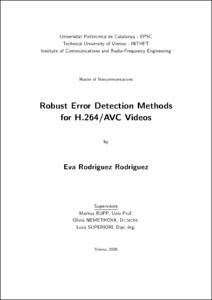Mostra el registre d'ítem simple
Robust error detection methods for H.264/AVC videos
| dc.contributor | Ruiz Boqué, Sílvia |
| dc.contributor.author | Rodríguez Rodríguez, Eva |
| dc.contributor.other | Universitat Politècnica de Catalunya. Departament de Teoria del Senyal i Comunicacions |
| dc.date.accessioned | 2009-02-12T12:57:31Z |
| dc.date.available | 2009-02-12T12:57:31Z |
| dc.date.issued | 2008-09-23 |
| dc.identifier.uri | http://hdl.handle.net/2099.1/6134 |
| dc.description.abstract | The 3rd generation of mobile systems is mainly focused on enabling multimedia services such as video streaming, video call and conferencing. In order to achieve this, the Universal Mobile Telecommunications System (UMTS), is the standard that has been developed by the 3rd Generation Partnership ect (3GPP) in Europe, including the baseline profile of H.264/AVC in the specification. With the union of both technologies a great improvement on video transmission over mobile networks, and even modification of the user habits towards the use of the mobile phone is expected. Nevertheless, video transmission has always been related to wired networks and unfortunately the migration to wireless networks is not as easy as it seems. In real time applications the delay is a critical constraint. Usually, transmission protocols without delivery warranties, like the User Network Protocol (UDP) for IP based networks, are used. This works under the assumption that in real time applications dropped packets are preferable to delayed packets. Moreover, in UMTS the network needs to be treated in a different way, thus the wireless channel is a prone error channel due to its high time variance. Typically, when transmitting video, the receiver checks whether the information packet is corrupted (by means of a checksum) or if its temporal mark exceeds the specified delay. This approach is suboptimal, due to the fact that perhaps the video information is not damaged and could still be used. Instead, residual redundancy on the video stream can be used to locate the errors in the corrupted packet, increasing the granularity of the typical upper-layer checksum error detection. Based on this, the amount of information previous to the error detection can be decoded as usually. The aim of this thesis is to combine some of the more effective methods concretely, Syntax check, Watermarking and Checksum schemes have been reformulated, combined and simulated. |
| dc.language.iso | eng |
| dc.publisher | Universitat Politècnica de Catalunya |
| dc.rights | Attribution-NonCommercial-ShareAlike 3.0 Spain |
| dc.rights.uri | http://creativecommons.org/licenses/by-nc-sa/3.0/es/ |
| dc.subject | Àrees temàtiques de la UPC::Enginyeria de la telecomunicació::Processament del senyal::Processament de la imatge i del senyal vídeo |
| dc.subject | Àrees temàtiques de la UPC::So, imatge i multimèdia |
| dc.subject | Àrees temàtiques de la UPC::Enginyeria de la telecomunicació::Radiocomunicació i exploració electromagnètica::Comunicacions mòbils |
| dc.subject.lcsh | Multimédia |
| dc.subject.lcsh | Mobile communication systems |
| dc.subject.other | UMRS |
| dc.subject.other | Multimedia services |
| dc.subject.other | Video transmission |
| dc.subject.other | Residual redundancy |
| dc.subject.other | Syntax check |
| dc.subject.other | Watermarking |
| dc.subject.other | Checksum |
| dc.title | Robust error detection methods for H.264/AVC videos |
| dc.type | Master thesis |
| dc.subject.lemac | Vídeo digital |
| dc.subject.lemac | UMTS (Universal Mobile Telecommunications System) |
| dc.rights.access | Open Access |
| dc.audience.educationlevel | Màster |
| dc.audience.mediator | Escola Politècnica Superior de Castelldefels |


